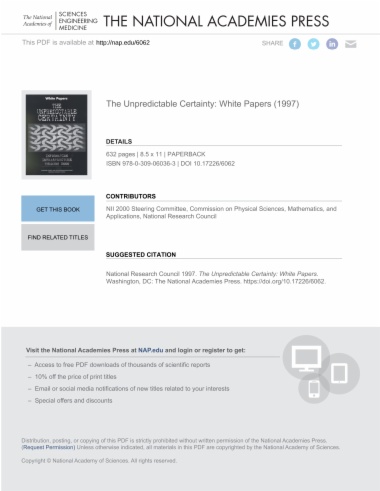This book contains a key component of the NII 2000 project of the Computer Science and Telecommunications Board, a set of white papers that contributed to and complements the project's final report, The Unpredictable Certainty: Information Infrastructure Through 2000, which was published in the spring of 1996. That report was disseminated widely and was well received by its sponsors and a variety of audiences in government, industry, and academia. Constraints on staff time and availability delayed the publication of these white papers, which offer details on a number of issues and positions relating to the deployment of information infrastructure.
- Cover
- Front Matter
- The National Information Infrastructure and the Earth Sciences: Possibilities and Challenges
- Government Services Information Infrastructure Management
- Cutting the Gordian Knot: Providing the American Public with Advanced Universal Access in a Fully Competitive Marketplace at the Lowest Possible Cost
- The Role of Cable Television in the NII
- Competing Definitions of 'Openness' on the GII
- Communications for People on the Move: A Look into the Future
- Building the NII: Will the Shareholders Come? (And if They Don't, Will Anyone Really Care?)
- The Electronic Universe: Network Delivery of Data, Science, and Discovery
- An SDTV Decoder with HDTV Capability: An All-Format ATV Decoder
- NII and Intelligent Transport Systems
- Post-NSFNET Statistics Collection
- NII Road Map: Residential Broadband
- The NII in the Home: A Consumer Service
- Internetwork Infrastructure Requirements for Virtual Environments
- Electric Utilities and the NII: Issues and Opportunities
- Interoperation, Open Interfaces, and Protocol Architecture
- Service Provider Interoperability and the National Information Infrastructure
- Funding the National Information Infrastructure: Advertising, Subscription, and Usage Charges
- The NII in the Home
- The Evolution of the Analog Set-Top Terminal to a Digital Interactive Home Communications Terminal
- Spread ALOHA Wireless Multiple Access: The Low-Cost Way for Ubiquitous, Tetherless Access to the Information Infrastructure
- Plans for Ubiquitous Broadband Access to the National Information Infrastructure in the Ameritech Region
- How Do Traditional Legal, Commercial, Social, and Political Structures, When Confronted with a New Service, React and Interact?
- The Internet, the World Wide Web, and Open Information Services: How to Build the Global Information Infrastructure
- Organizing the Issues
- The Argument for Universal Access to the Health Care Information Infrastructure: The Particular Needs of Rural Areas, the Poor, and the Underserved
- Toward a National Data Network: Architectural Issues and the Role of Government
- Statement on National Information Infrastucture Issues
- Proposal for an Evaluation of Health Care Applications on the NII
- The Internet - A Model: Thoughts on the Five Year Outlook
- The Economics of Layered Networks
- The Fiber-Optic Challenge of Information Infrastructure
- Cable Television Technology Deployment
- Privacy, Access and Equity, Democracy, and Networked Interactive Media
- As We May Work: An Approach Toward Collaboration on the NII
- The Use of the Social Security Number as the Basis for a National Citizen Identifier
- Estimating the Costs of Telecommunications Regulation
- Residential PC Access: Issues with Bandwidth Availability
- The National Information Infrastructure: A High Performance Computing and Communications Perspective
- Nomadic Computing and Communications
- NII 2000: The Wireless Perspective
- Small Manufacturing Enterprises and the National Information Infrastructure
- Architecture for an Emergency Lane on the NII: Crisis Information Management
- Aspects of Integrity in the NII
- What the NII Could Be: A User Perspective
- Role of the PC in Emerging Information Infrastructures
- NII Evolution - Technology Deployment Plans, Challenges, and Opportunities: AT&T Perspective
- Enabling Petabyte Computing
- Private Investment and Federal National Information Infrastructure Policy
- Thoughts on Security and the NII
- Trends in Deployments of New Telecommunications Services by Local Exchange Carriers in Support of an Advanced National Information Infrastructure
- The Future NII/GII: Views of Interexchange Carriers
- Technology in the Local Network
- Recognizing What the NII Is, What It Needs, and How to Get It
- Electronic Integrated Product Development as Enabled by a Global Information Environment: A Requirement for Success in the Twenty-first Century
- Interoperability, Standards, and Security: Will the NII Be Based on Market Principles?
- Technology and Cost Models for Connecting K-12 Schools to the National Information Infrastructure
- Geodata Interoperability: A Key NII Requirement
- Electronic Commerce
- Prospects and Prerequisites for Local Telecommunications Competition: Public Policy Issues for the NII
- The Awakening 3.0: PCs, TSBs, or DTMF-TV - Which Is Right for the Next Generation's Public Network?
- Effective Information Transfer for Health Care: Quality versus Quantity
- Integrating Technology with Practice: A Technology-enhanced, Field-based Teacher Preparation Program
- RegNet: An NPR Regulatory Reform Initiative Toward NII/GII Collaboratories
- Electronic Document Interchange and Distribution Based on the Portable Document Format, an Open Interchange Format

